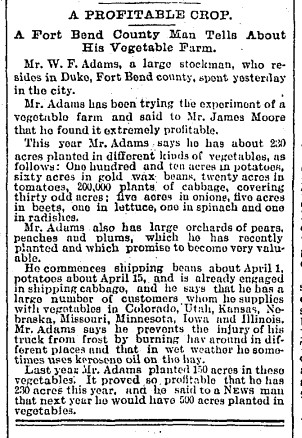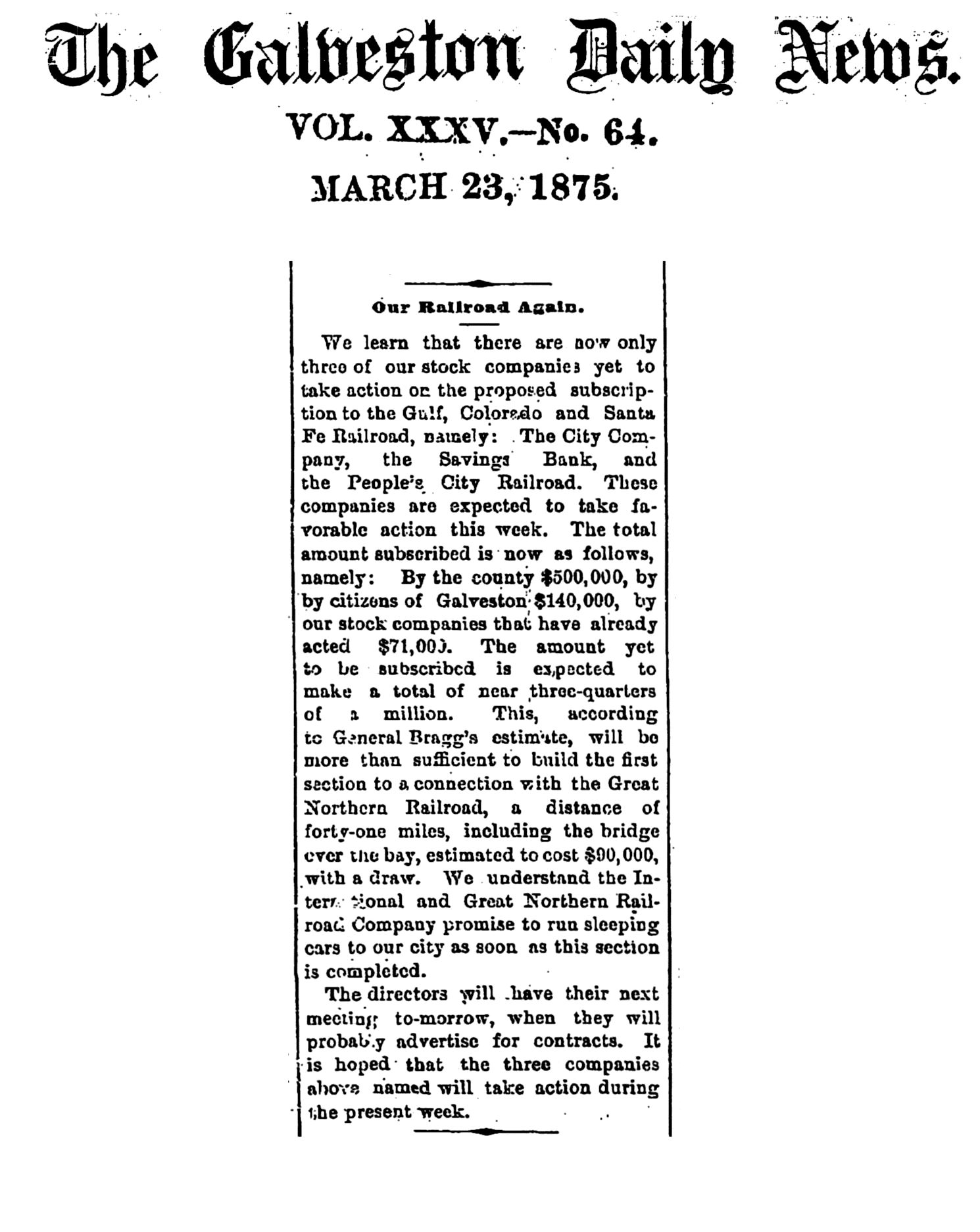
The map below shows Clear Lake

Duke, Texas
Marker is located on the east bound side of State Highway 6 at the intersection of Post Oak in Arcola, Texas.[2008]
Duke Community In 1824, old three-hundred settlers David Fitzgerald, Thomas Barnett and Moses Shipman, received land grants in this area. Fitzgerald fought at Anahuac in 1832; Barnett signed the Texas Declaration of Independence. This location on the northeastern high bluff of Clear Lake, an ample supply of water for steam engines, led to the construction of railroads here by the mid-1800s. Duke was terminus of the Sugar Land Railway for loading sugarcane. The area developed as a major shipping point with a store, hotel, livestock pen, and sugar mills. It was named for Duke Hessey, the storekeeper. Duke had a Post Office from 1883 to 1922; the first Postmaster was J. R. Fenn. Today, Duke Cemetery is the only remnant of this once-thriving community.

The map below shows Clear Lake

Discontinued 17 Nov 1851
DUKE, TEXAS- POSTMASTERS
Fenn, John R., 16 Nov 1883
Discontinued 31 Dec 1922; mail to Thompson
|
Recollection of Duke, Texas, written probably by G. T. Snedecor who died in 1946.
"Duke, Fort Bend County, Texas,
This is a plantation town, or station, almost obscure at present, once a thriving little place, it was owned and operated by Col. J. R. Fenn for many years. Mr. Fenn built the place upon his ranch and plantation and it was named sometime about the year 1872; there was an immense pavilion and picnic grounds upon a beautiful lake, Clear Lake, where boating, and every variety of pleasure were once had; the ground and park were maintained by the Santa Fe Railroad Co., it has long since crumbled down and the Park and Lake a wilderness now. It became inactive about 1900: up to 1896 it was a week-end resort for Galveston and Houston City pleasure seekers. Named after Duke Hesse, Manager for Mr. Fenn." |
Vinces Farm
In 1840 Allen Vince owned a stock ranch on Vince's Bayou and farmed corn on Oyster Creek. He is best known for building the bridge that Deaf Smith, Sam Houston's famous scout, and a companion crossed and later destroyed the morning of the Battle of San Jacinto. Vinces Place on Oyster Creek was situated along State Highway 6 near Duke [Arcola].
Long Point Creek not Oyster Creek is near Duke. Arcola was not formed until 1865. Because most historians don't kmow about the community of Duke, Arcloa is used as a refference. State Highway 6 and Oyster Creek is near Trammells.
|
The error that changed local history David Fitzgerald arrived in this Mexican run territority of Texas in late 1821. He began building his home on property he wanted to claim. When he went to San Felipe to file his claim, Steven F. Austin informed him the League was already claimed by William Morton. William Morton agreed to trade David Fitzgerald 1/4 of his League for 1/4 of the League David Fitzgerald would claim, thus allowing David to own the home he was building. David Fitzgerald claimed his League 20 miles downstream on the Brazos River. The trade was not immediately recorded, mainly because the area belonged to Mexico and recording land transactions was difficult. David died in 1832, shortly after participating in the battle of Annahuac. William Morton drowned in the Brazos River in 1833, leaving a wife, Nancy, a son, John V., and two daughters, Louisa Ann and Mary. David's daughter, Sarah, married Eli Fenn and they continued to live in the home David built on the Morton League. The decendents of the Fitzgerald and Morton famlies eventually filed the land transaction for the 1/4 League trade. The Morton familly lived on the west side of the Brazos River until the death of William, when Nancy moved the family to the east side of the river closer to the Fenn family. Nancy sold the property on the west side to developers who would create Richmond, Texas. Louisa Ann Morton married Daniel Perry on December 24, 1833 and they moved to the land obtained by the 1/4 League trade [the Duke area] in 1834. In 1836, after the fall of the Alamo, General Santa Anna chased General Sam Houston causing the settlers to flee in what is known as the 'Runnaway Scrape'. The Morton and Fenn homes were destroyed by the Mexican Army. Both families relocated on the Fitzgerald League. The Fenn family lived with Moses Shipman until they completed their new home. The Morton family lived with Daniel and Louisa Ann [Morton] Perry on the 1/4 League they had gained by trade. Also in the year of 1836, John V. Morton married Elizabeth Shipman, they were the son and daughter of two 'Original 300' settlers. Because David Fitzgerald built his home on land that wasn't his, an agreement to trade 1/4 League with William Morton was formed with the traded land became the new home for the Morton family after the Mexican Army destroyed their previous home. |
THE COMPLETE STORY
Along the southern edge and
parallel to the runway of the
Point Creek and FM 521 called “Duke Siding”. Still standing is a sign “Duke” showing the location of DUKE
Station in 1890.
The lake water is replenished when Long Point Creek rises and
rise. The east bank of
made this location desirable.
Prior to and during the early 1800's this area was populated by Karankawa Indians. It is this location and the
surrounding area that some of the first Old Three-Hundred settlers received land grants after 1824, such as
Moses Shipman, David Fitzgerald, and Thomas Barnett. In time, other early settlers also lived here, such as the
Morton's, the Fenn's, and the Perry's.
Starting 1824, Steven F. Austin awarded land grants in this area. These settlers were known as Steven F.
Austin's Old Three Hundred and this was a part of the first Anglo Colony in Texas. DUKE will be located on the
northeast bluff of Clear Lake in the Thomas Barnett league just north of the northern boundary of the David
Fitzgerald league. The Moses Shipman league is just north of the Thomas Barnett league and his is the only
league of the three that doesn't border on the Brazos River. In the era before the railroads the Brazos River was
the transportation to markets.
Moses Shipman was born September 22, 1774 in Kentucky. On January 19, 1798 Moses married Mary
Robinson, daughter of John Robinson, of South Carolina. Their first son died in infancy. They raised five sons
and four daughters. In 1825 the Shipmans moved to their league near what would be DUKE.
Thomas Barnett came to Texas in 1823 from Livingston county, Kentucky. He never lived on the Thomas Barnett
league. He later married the widow of William S. Spencer and lived on the Nancy Spencer league. He signed the
Texas Declaration of Independence.
David Fitzgerald of Savannah, Georgia, came to Texas in 1822 and built his home on land he wanted
to receive from Steven F Austin. The land had already been granted to William Morton however. William Morton was kind enough to promise David Fitzgerald 1/4 of his William Morton league and David
Fitzgerald promised to give William Morton 1/4 of his league when he received it. Bothmen would die before the
end of 1833 and therefore never lived under the Republic of Texas. Under the rule of the Mexican government
land transfers were, at best, difficult. Their promise to trade land was completed by their decedents under the
Republic of Texas.
In 1831, Kentucky-born John Davis Bradburn, who was serving as a colonel in the Mexican army, took command
of the garrison at Anahuac, the small American community on Galveston Bay. This was a port of entry for
American colonists that had been established as a Spanish fortress ten years before. Without reason, and not
long after his arrival, Bradburn abolished the settlement of Liberty and confiscated the colonist's land. He
declared martial law and arrested several of them after they protested. One hundred sixty angry colonists,
including David Fitzgerald and the son of Moses Shipman, Daniel Shipman, attacked the garrison to rescue their
friends. At the mouth of the Brazos River, another group onthe way to Anahuac battled with Mexican troops at
Velasco and defeated them. This was the start of the Texas Revolution.
In 1832, shortly after he took part in the battle of Anahuac, David Fitzgerald died. Three month's earlier, his son in law, Eli Fenn, came looking for him because he and his wife, Sarah Fitzgerald Fenn, had heard nothing from her father in the ten years he had been in Texas. They were living in Lawrence county, Mississippi when Eli and Sarah's son, John Rutherford Fenn was born on October 11, 1824. They later moved to Madison county Mississippi. Eli liked the area in Texas and went back to Mississippi for his family. Eli
Fenn arrived back in Texas with his family in June of 1833, just missing the calamanty mentioned above.
They settled on the Fitzgerald property near Richmond. During the flood of 1833, William Morton was on his
plantation a mile from home on the east side of the Brazos River and was carried away by the flood waters.
Some sources say he was attempting to swim across the river from his home on the east side to the west side where his growing crops were. He was never found. Randal Jones was the last person to see him alive. Daniel Perry was administrator of the Morton estate. James Perry, the brother of Daniel Perry, came to Texas in
1829-1830. On December, 1832, James received a league of land on Davidson Creek a few miles north of Lyons,
in Burleson County. Daniel Perry, his wife Eliza Jane Whitehead, and two sons, James Whitehead and Samuel,
arrived in Texas in June 1832 and lived with Daniel's brother James until he could find a place to make his
home. During this time his wife Eliza died. At a party hosted byThomas Barnett, Daniel met Louisa Ann Morton,
also known as Louisiana Morton, daughter of William Morton and on December 24, 1833, they were married.
Daniel Perry, his wife Louisa Ann, and his two sons James Whitehead and Samuel settled on the Morton
property [DUKE] that Louisa Ann inherited from her father, William Morton. Not long afterward Samuel, age 12,
drowned in the Brazos River. His body was never recovered.
Moses Shipman was president of the election at the home of John Owens to choose delegates to the Convention of 1836. This
convention resulted in Texas Deceleration of Independence from Mexico. Thomas Barnett also signed the Texas
Declaration of Independence. The day the Alamo fell Daniel Perry joined the Texas Army at Richmond as Captain.
Following the fall of the
Santa Anna was defeated by Sam Houston in the Battle of San Jacinto. The pursuit of General Sam Houston by General
Santa Anna became known as the Runaway Scrape in which Santa Anna burned all the settlers homes he could find. During the Runaway Scrape to escape the Mexicanarmy in 1836, families of all these settlers were
included. Returning home after the Battle of San Jacinto and victory for the Texans, many found their homes destroyed,
livestock gone, and fields ruined. The Fitzgeraldhouse where the Fenn's lived was destroyed; so were Moses Shipman’s pens
andstock at Stafford’s Point where the Mexicans had camped. The homes of Daniel Perry and Moses Shipman were
standing, so the Fenns moved in with Moses and Mary Shipman until they could build on the David Fitzgerald league at
DUKE. Eli Fenn was part of Martin's 100 and would defend the crossings along the Brazos in the Fort Bend
area. Martin and his men were unable to defend them all. The Battle of San Jacinto on April 21, 1836 ended the
war. Early in the year of 1837 and shortly after signing the petition to form Fort Bend County, Moses Shipman
died. His widow, Mary, lived on her league until her death.In 1837, Sarah and Eli moved to a quarter league
which she inherited from her father on the upper edge or west end of the Fitzgerald grant, fronting on the
Brazos River.
Fort Bend County was formed in 1838; the DUKE area residents who signed the petition on May 15, 1837, for the
formation of the county were Moses Shipman, Eli Fenn, Daniel Perry, and James P. Shipman. The candidates for sheriff were James Perry, Daniel Perry’s brother, and John V. Morton, Daniel Perry’s brother-in-law, James Hughes and Adam Stafford.. Daniel served as election judge. John V. Morton was elected.
In 1840, Eli Fenn died. The cause of his death at age 46 is not known. John Fenn, who was 16 at the time of his
fathers death, later said he buried his father about 400 yards below where the bridge of the Santa Fe Railroad
spans the Brazos. The exact spot is lost. In 1841, Eli's widow, Sarah, sold land in the David Fitzgerald league to
Robert G. Waters. Waters sold it to his uncle, Jonathan Waters in 1846.
On February 7, 1843, Sheriff John V. Morton was shot and killed in a dispute with his deputy George W. Pleasants. The details of the incident are not known.
Louisa Ann Morton Perry, Daniel's second wife and the sister of John V. Morton died sometime between 1843
and 1849. Nancy Morton, wife of William, lived with Daniel and his family to help raise her grandchildren.
Texas joined the Union February 19, 1846. Daniel Perry married Jane Hogue in 1851. The year 1852 saw the
marriage of John R. Fenn to Rebecca Williams, who lived at the neighboring plantation of Moses Shipman. He
was 28; she was 17. In the following years John began accumulating land in and around the Thomas Barnett
league. The southeastern high bluff of Clear Lake was his homestead. The northeastern high bluff became
Duke.
Before the Civil War, there were ten railroads operating in Texas. The first was the Buffalo Bayou, Brazos &
Colorado RR from Harrisburg to Stafford Point and started operation in 1853. The Columbia Tap traveled from
Pierce Junction, at Houston, past DUKE, to the east bank of the Brazos at Columbia, a distance of 50 miles. It
made its first run in late 1859. The train consisted of two engines, one passenger car, seven box cars, and
eighteen platform freightcars. The Civil War halted its operation.
Sarah Fitzgerald Fenn Cox, born 1797, died in 1860. General Sam Houston died in 1863.
The Civil War ended in 1865. Most wealthy plantation owners were in dire straights because they spent
everything on the war effort. Labor for the fields was non-existent. The Arcola community was formed. Daniel
Perry moved to Houstonin 1865 and would travel by train to Stafford Point and by horse to Duke. He died in
Houston November 9,1869 and took his last ride to Duke.
In 1872, Jonathan Waters's widow sold the property, that Sarah Fenn sold in 1841, to Thomas Pierce. That
same year, 1872, T.W. House purchased the property from Pierce. During the time House owned the Plantation,
John R. Fenn worked for him. In 1876, Fenn bought 75 acres of land in the Fitzgerald league from Jane H.
Perry.
The Houston Tap and Brazoria railroad, built beside the right of way of the Columbia Tap, was from Houston,
past DUKE, to Brazoria and sold to International and Great Northern [ I&GN ] in 1871. Gulf, Colorado & Santa
Fe started building in 1873 and opened in 1875 from Richmond to Galveston. A direct route from Richmond to
Galveston would be closer to Rosharon, so a more accurate description of the chosen route is from Richmond to
DUKE then DUKE to Galveston. These early train engines were steam, steam comes from water, and DUKE had
the water from Clear Lake. There was a railroad water tower still standing at DUKEi n 1970. The
Sugar Land Railroad was funded in 1893 and one of the board of directors, J H B House, was from
DUKE, Texas. Duke in 1909map shows a store and hotel and how the Cunningham "Sugar Land road"
railroad connected with the Gulf, Colorado & Santa Fe and then with I&GN. This "Sugar Land road" was about
800 feet south of today's McKeever Rd.
John R. Fenn had built a general mercantile store, a hotel and a stock pen in the DUKE area. Duke Hessey was the
storekeeper, so the place became known as DUKE when the railroad established a stop there. It was also known as Duke
Station, Clear Lake Station, and
31, 1922; John R. Fenn was the first postmaster.
In October 1888 the Young Men’s Democratic Club of Fort Bend County met at DUKE on the picnic grounds in
the“horseshoe” of
hoping for a compromise about candidates for public office in the county. Francis Marion Otis Fenn, son of John
R. Fenn, wore his black broadcloth
the county presided in his happiest manner to make everybody feel at home. In 1889 this club became the
Jaybird Democratic Association of Fort Bend County; F. M. O. Fenn was secretary, and his father, John R. Fenn
served on the Executive Committee. This organization was to provide the people
of
with economical and honest county government after the carpet bagger control .
GALVESTON DAILY NEWS APRIL 3, 1894
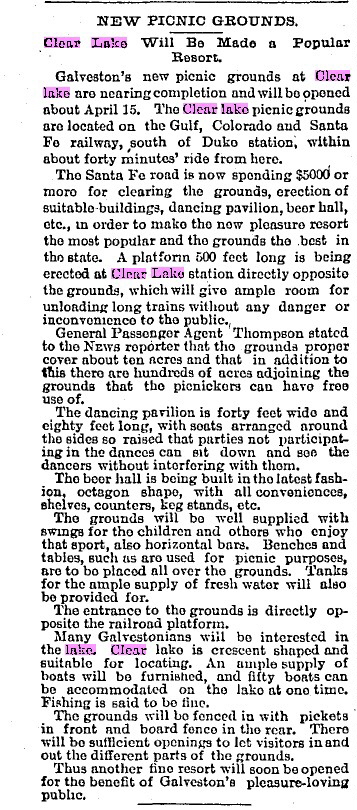
GALVESTON DAILY NEWS MARCH 24,1892
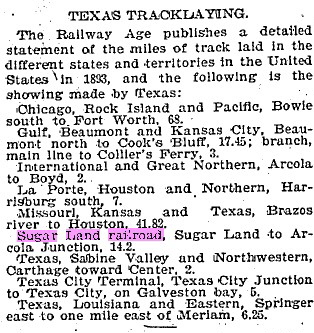
The hurricane of 1900 destroyed Daniel Perry’shouse. Also the house where Mr. Hubbardlived on the John R. Fenn farm
was partly wrecked, and the family ran out toseek another place of refuge. Mrs. Hubbard held the two-month old baby, and
Mr. Hubbard took care of the children who could walk. A tree blew down on themother, breaking her back, but she was still
clinging to the child in her armswhen rescued. She was fatally hurt and died within a month and was buried at DUKE
cemetery.
In 1903, T.H. Scanlan purchased the Arcola Sugar Plantation from T.W. House.
On
possibly his grandfather David Fitzgerald at DUKE. Eight months later, in July of 1905, RebeccaWilliams Fenn was laid to
rest beside her husband John Rutherford Fenn.
Some time after 1892 Francis Marion Otis Fenn, son of John R. Fenn, wrote to the Editor of the Texas Coaster
newspaper to say “
known to man.” His father and T. W. House, banker and sugarplanter, sent a box of Oyster Creek soil to the
first Paris Exposition, whereit was analyzed; and a like amount from the fertile valley of the River Nile,which had
always been considered the finest in the world, which when analyzed,was found to be inferior to the Oyster
Creek land, which won the goldmedal. This box of soil was returned andthen went to the Smithsonian Institute
in
GALVESTON DAILY NEWS MAY 29,1886

GALVESTON DAILY NEWS JULY 13, 1884
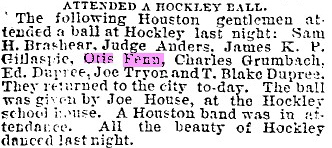
DAILY NEWS JULY 28, 1886
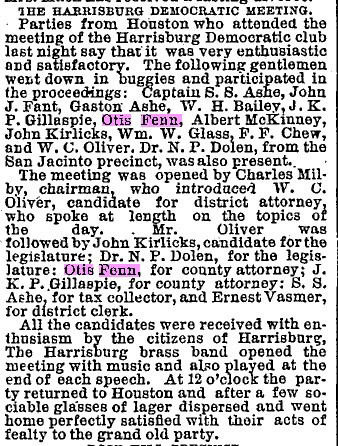
GALVESTON DAILY NEWS NOVEMBER 30, 1895
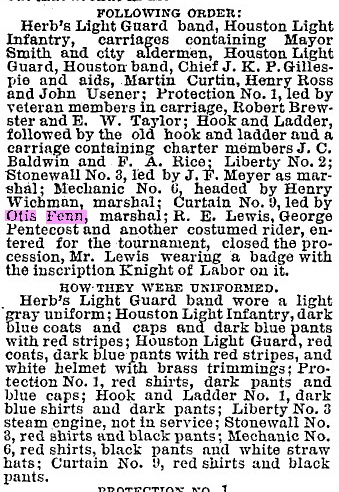
GALVESTON DAILY NEWS APRIL 22, 1886

The cemetery is located across
FitzgeraldFenn, John Rutherford Fenn, Rebecca Williams Fenn, members of the Williams family, Daniel Perry,
Perry childrenand Mrs. Hubbard. Probably Louisa AnnMorton Perry and her mother Nancy Spencer Morton are
also buried in this area,as well as David Fitzgerald. In 1901, W.P. Hamblin, son of Jane Hogue Hamblin Perry,
wife of Daniel Perry, deeded apart of the old Perry homestead, to be set aside as a cemetery.The cemetery is
referred to as the DUKE Cemetery there are no headstones in the cemetery. Eli Fenn was buried on
the
Shipman was buriednearby on his property.
sugar were sent by rail to the
last four operating in
from House, Texas to DUKE, Texas. With the introduction of the diesel locomotive, water was not necessary at
DUKE. Today there is a post near the railroad track with the sign on it that says “Duke”. DUKEwas a tight
communityof early settlers struggling to do what they could for their families,
the State of

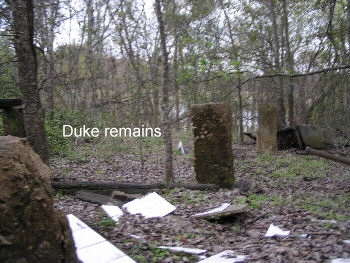
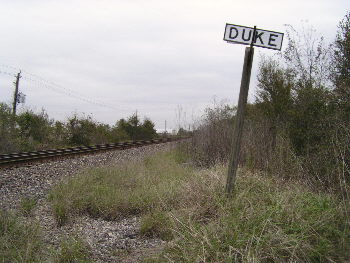
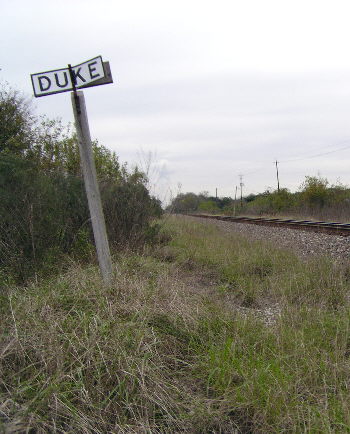
The following is about Joe and Mona Fenn's place.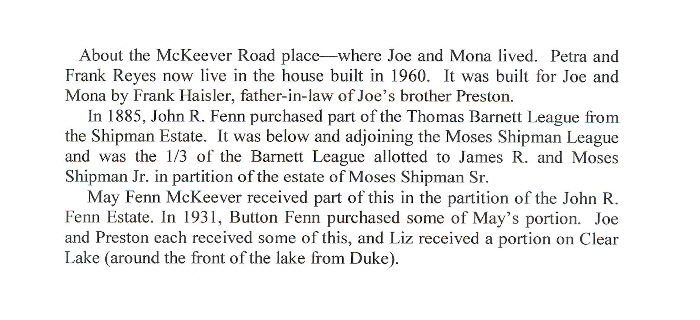
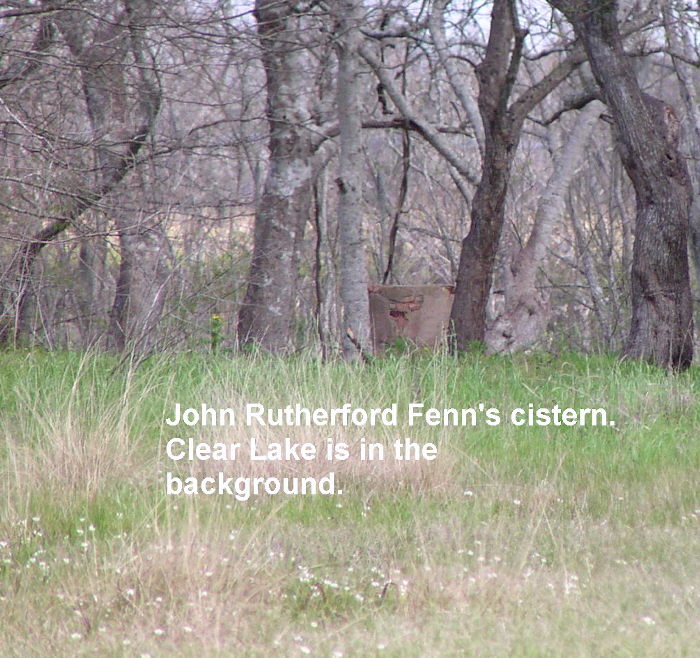
When the town of Almeda applied for a Post Office in 1893 the application required the listing of the two closest existing Post Offices. This one is at Duke.
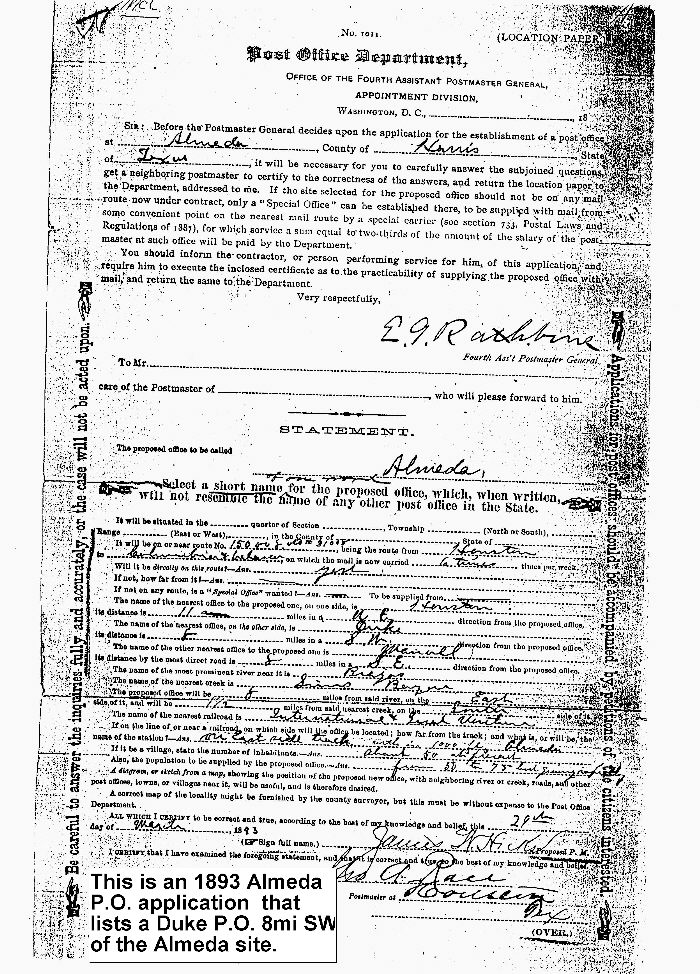
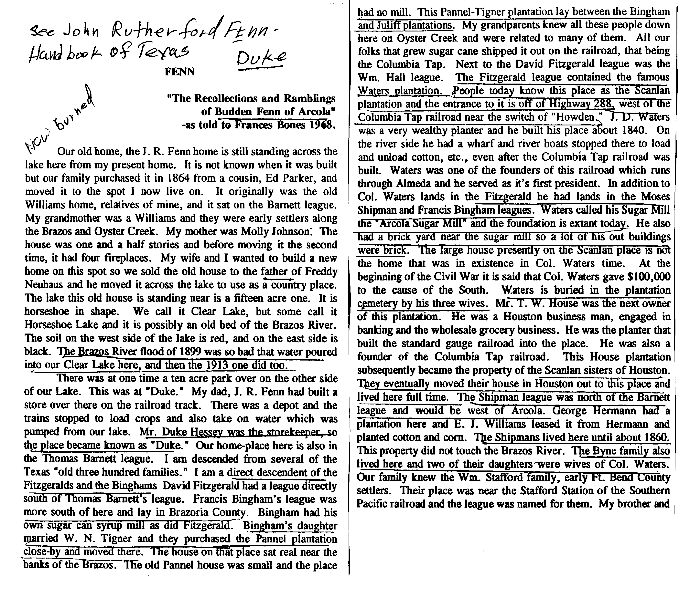
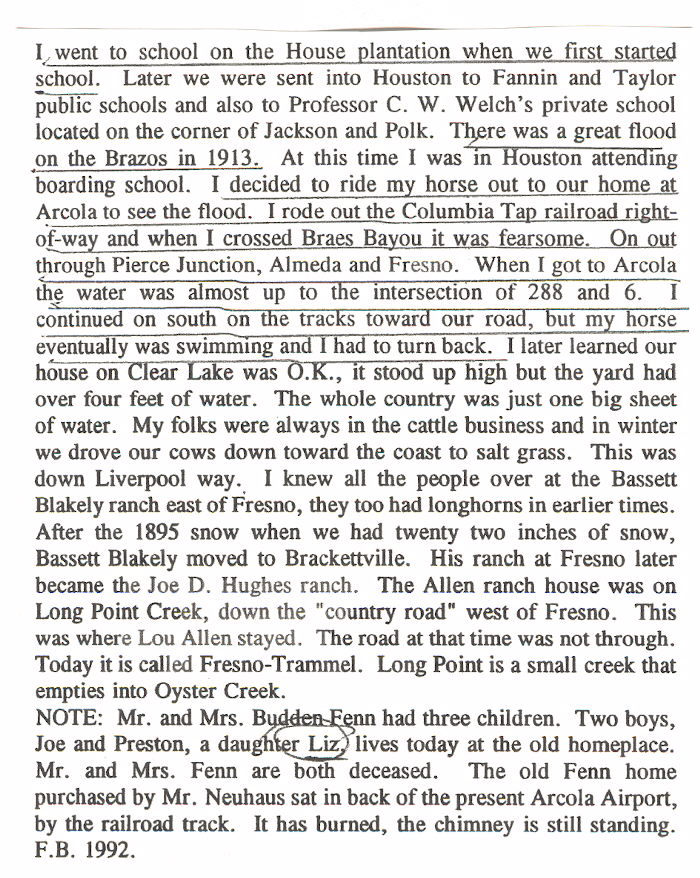
Bockel
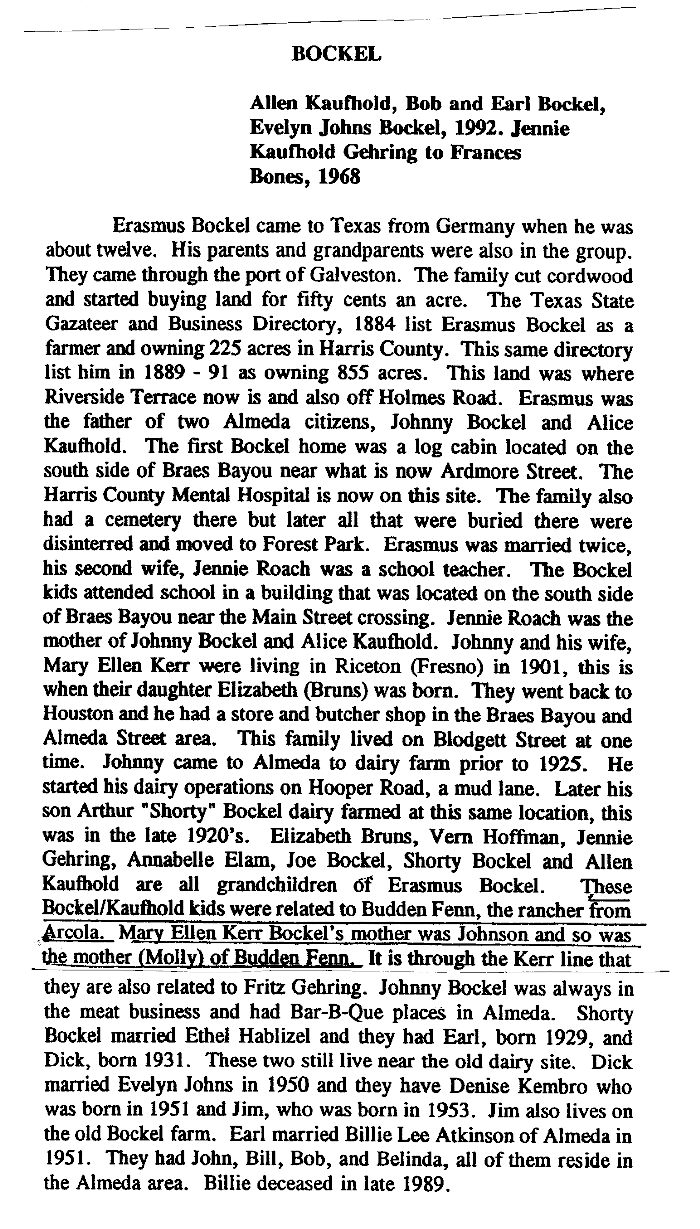
July 6 1901, The Houston Daily Post, page 7

The Galveston Daily News March 12, 1892
